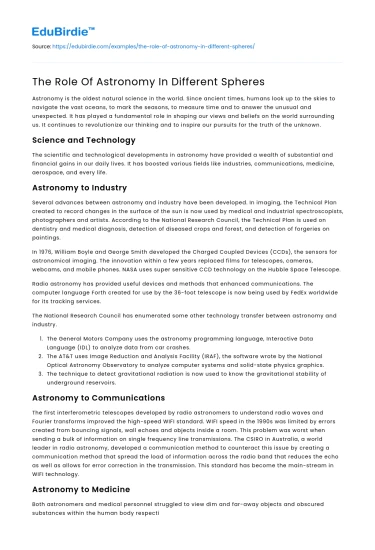Astronomy is the oldest natural science in the world. Since ancient times, humans look up to the skies to navigate the vast oceans, to mark the seasons, to measure time and to answer the unusual and unexpected. It has played a fundamental role in shaping our views and beliefs on the world surrounding us. It continues to revolutionize our thinking and to inspire our pursuits for the truth of the unknown.
Science and Technology
The scientific and technological developments in astronomy have provided a wealth of substantial and financial gains in our daily lives. It has boosted various fields like industries, communications, medicine, aerospace, and every life.
Save your time!
We can take care of your essay
- Proper editing and formatting
- Free revision, title page, and bibliography
- Flexible prices and money-back guarantee
Astronomy to Industry
Several advances between astronomy and industry have been developed. In imaging, the Technical Plan created to record changes in the surface of the sun is now used by medical and industrial spectroscopists, photographers and artists. According to the National Research Council, the Technical Plan is used on dentistry and medical diagnosis, detection of diseased crops and forest, and detection of forgeries on paintings.
In 1976, William Boyle and George Smith developed the Charged Coupled Devices (CCDs), the sensors for astronomical imaging. The innovation within a few years replaced films for telescopes, cameras, webcams, and mobile phones. NASA uses super sensitive CCD technology on the Hubble Space Telescope.
Radio astronomy has provided useful devices and methods that enhanced communications. The computer language Forth created for use by the 36-foot telescope is now being used by FedEx worldwide for its tracking services.
The National Research Council has enumerated some other technology transfer between astronomy and industry.
- The General Motors Company uses the astronomy programming language, Interactive Data Language (IDL) to analyze data from car crashes.
- The AT&T uses Image Reduction and Analysis Facility (IRAF), the software wrote by the National Optical Astronomy Observatory to analyze computer systems and solid-state physics graphics.
- The technique to detect gravitational radiation is now used to know the gravitational stability of underground reservoirs.
Astronomy to Communications
The first interferometric telescopes developed by radio astronomers to understand radio waves and Fourier transforms improved the high-speed WIFI standard. WIFI speed in the 1990s was limited by errors created from bouncing signals, wall echoes and objects inside a room. This problem was worst when sending a bulk of information on single frequency line transmissions. The CSIRO in Australia, a world leader in radio astronomy, developed a communication method to counteract this issue by creating a communication method that spread the load of information across the radio band that reduces the echo as well as allows for error correction in the transmission. This standard has become the main-stream in WIFI technology.
Astronomy to Medicine
Both astronomers and medical personnel struggled to view dim and far-away objects and obscured substances within the human body respectively. Both disciplines require accurate, detailed and high-resolution images. The Swedish Academy of Science resolved this issue. In 1974, astronomers Nobel Laureate and Martin Ryle developed the Aperture Synthesis used in computerized tomography (CT scan, magnetic resonance imaging (MRI), position emission tomography (PET) and many other medical imaging tools.
Astronomy also developed programming languages to make image processing easier. Sveta Shaharina, an expert of scientific data management, visualization, and UX cited that the IDL and IRAF are two widely-used languages for medical applications.
Another astronomical research contribution to the medical world was the manufacture of space-based telescopes that require extremely clean environment to prevent dust to obstruct the instrument. The clean-room protocols, air filters and bunny suits developed in response to the issue are now also used in hospitals and pharmaceutical laboratories.
There are more tools developed for astronomy that are being used in medicine. Some of these are the small thermal sensor initially developed to control telescope’s temperature is now used to control heating in neonatal units, low-energy x-ray scanner developed by NASA is currently used by US Food and Drug Administration (FDA) to study pill contamination, and many more.
Astronomy to Aerospace and Energy
Astronomy and Aerospace sector share many technologies such as the method of observing stars and models are used to differentiate between rocket plumes and cosmic objects, method of observing stellar distribution on the sky is used in aerospace engineering, the solar blind counter to measure particles of light from a source is now used to detect toxic gases and ultraviolet photons from missiles, and the Global Positioning System (GPS) satellites that rely on astronomical objects (such as quasars and distant galaxies) to determine accurate positions.
On the other hand, the National Research Council cited that astronomical methods can be used to find new fossil fuels for renewable energy source.
People encounter on an everyday basis many useful astronomical technologies. Its tangible and intangible contributions provide people with skills and insights to effectively resolve issues and concerns in different sectors of society. And more importantly, it has made us aware of how we fit into the vast Universe.
Carl Sagan, an American astronomer, in his book Pale Blue Dot book said: “It has been said that astronomy is a humbling and character-building experience. There is perhaps no better demonstration of the folly of human conceits than this distant image of our tiny world. To me, it underscores our responsibility to deal more kindly with one another, and to preserve and cherish the pale blue dot, the only home we’ve ever known.”






 Stuck on your essay?
Stuck on your essay?

